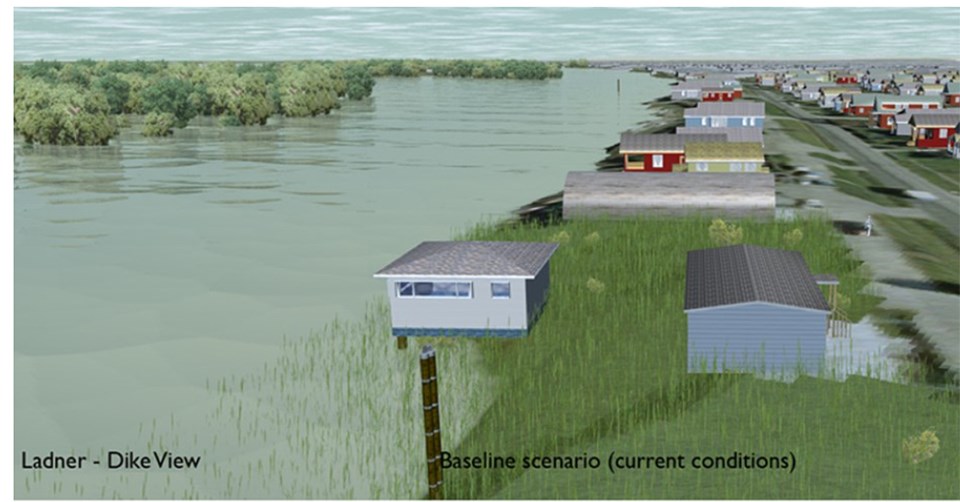Will the B.C. government help the City of Delta with the city’s $1.9 billion diking dilemma?
The province last week announced that it is gathering public feedback through a recently released Intentions Paper outlining a proposed flood strategy that will manage flood safety risks in B.C.
The purpose is to also re-engage First Nations, Indigenous organizations and local governments.
The document provides discussion points about improved assessment, decision-making, preparedness and response and crucial investments to safeguard communities.
A section looking strengthening dikes and regulatory programs notes that over 216 dikes in B.C are provincially regulated. They protect 16,000 hectares of land containing well over half a million people and thousands of buildings, with a total estimated value of over $100 billion.
Currently, the vast majority no longer meet provincial standards, with one study estimating only five per cent of all dikes in the Lower Mainland meet current standards, the Intentions Paper warns.
The document also notes that there is a need to complete a publicly accessible, central repository of dike information, capturing the condition, height and key deficiencies of dikes.
The potential actions include, among other things, increased support for effective dike maintenance and diking authorities, as well as enabling more comprehensive flood risk assessments to prioritize funding for dike upgrades.
“In addition, increasing capacity of provincial regulatory staff would support improvements in dike regulatory programs, including approvals, auditing and compliance, guidance documents, and support for implementing innovative solutions,” the Intentions Paper notes.
The Intentions Paper goes on to suggest “A new, comprehensive set of guidelines for the design, construction, and management of dikes, erosion protection works is needed, and other flood infrastructure is needed, to reflect current science and engineering best practices, and include provisions for emerging bio-engineering and greener technologies.”
The paper is posted on the Engage BC website, and people have until Friday, Jan. 6, 2023 to provide detailed comments and submissions: https://engage.gov.bc.ca/govtogetherbc
The province is engaging with First Nations and local governments from October until December 2022.
A Delta staff report earlier this year on the city’s flood protection and infrastructure initiatives was discussed at the Climate Action and Community Livability Advisory Committee.
The report outlines some ominous numbers facing the city, which has more than 67 kilometres of dikes that require seismic and other upgrades to meet the latest standards.
Facing the risk of flooding from coastal storm surges as well as the Fraser River spring freshet, the estimated cost, so far, for dike raising and seismic improvements by 2100 is estimated at more than $1.9 billion, with the first phase alone, excluding seismic improvements, tabbed at $350 million.
The city currently has $6.5 billion in private property and public infrastructure protected by Delta’s diking infrastructure, while the estimated damage by a major dike breach is anywhere from $1 billion-to-$3 billion. About 53 per cent of Delta’s land mass is vulnerable to flooding.
With climate change, sea level rise is a significant threat for the lowlands of Delta, especially along Boundary Bay, according to another previous Delta staff report, adding the existing coastal dikes are at an elevation of 3.5 metres and currently do not adhere to the province's seismic guidelines.
Yet another report noted the goal by 2050 is to raise Delta’s dikes in a phased project that will take years to complete.
The Fraser Basin Council recommended establishing a long-term funding program to support the implementation of the Lower Mainland Flood Management Strategy, with senior level government financial support clearly needed.
Releasing its draft strategy last year, the Fraser Basin Council warned that the Lower Mainland will face $20-to-$30 billion in projected losses if multiple dike systems are unable to hold back floodwaters, given extensive development in flood hazard areas. Future growth projections indicate the region will increase by over a million people by 2050, so the risk will increase.
The City of Delta has been involved in numerous studies and undertaken various flood mitigation projects, including seeking long-term senior government funding for much-needed dike upgrades.
Some of the initiatives in Delta's Flood Management Strategy include extensive protection upgrades for the River Road West area, a flood protection strategy for Boundary Bay/Beach Grove, a Beach Grove seawall assessment, the Boundary Bay Construction Fill Pilot Dike Project, Chillukthan Drainage Pump Station upgrades, a new 84th Street Pump Station and the Mason Culvert upgrades.
The latest Delta report notes the next steps include developing a strategy road map, engaging residents, committing to a funding model and seeking senior government funding.
The report also outlined some of the key upcoming projects for Delta including the Ladner Waterfront Flood Protection Strategy.
The British Columbia Flood Strategy will be released in 2023.



